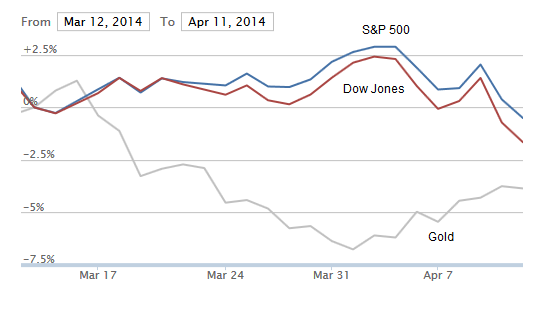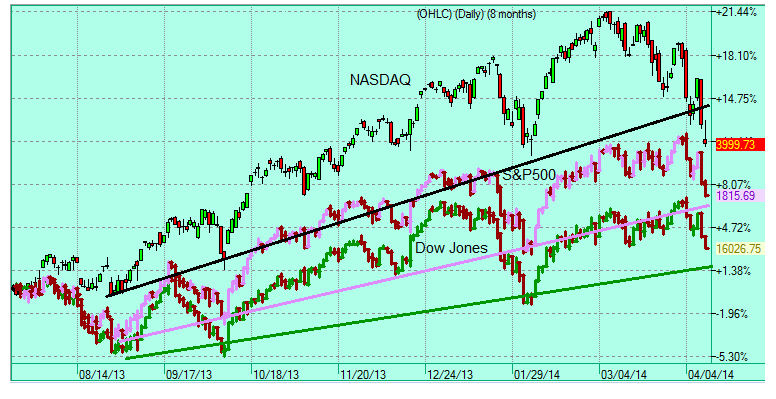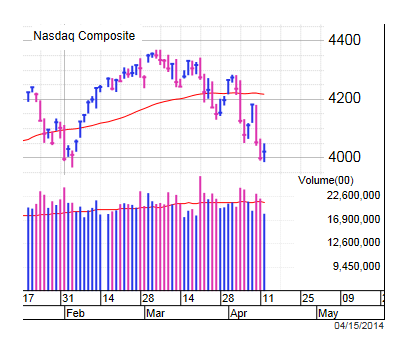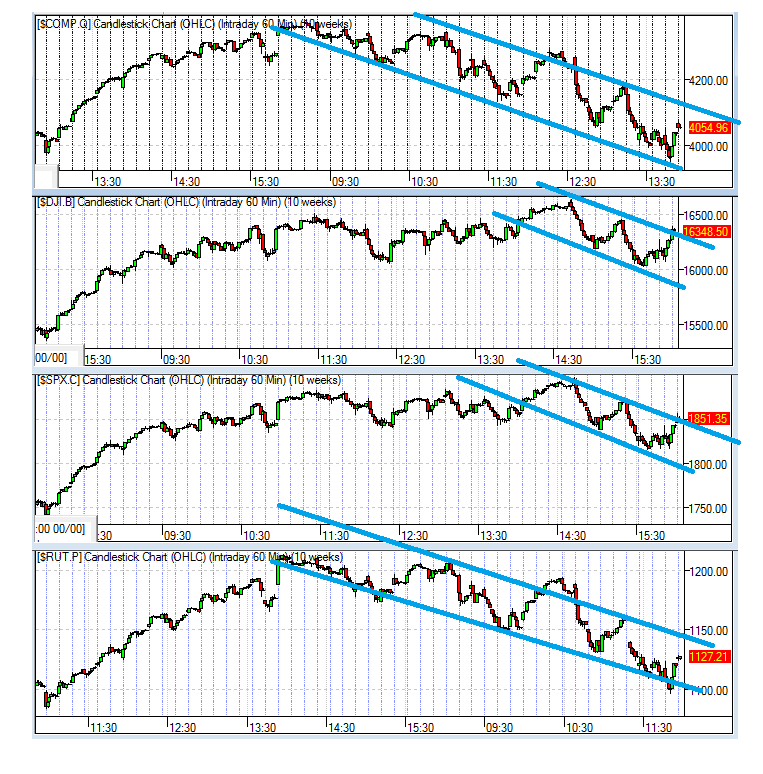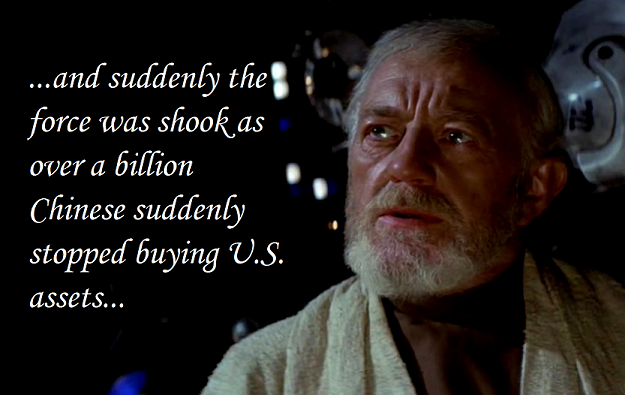So let's fast-forward to this week's office stock strategy pool. I'm voting for watching for this correction's 'follow-thru-day' and moving back in and enjoying the next run-up.
Yellen ON:
JANET YELLEN GIVES FIRST SPEECH ON MONETARY POLICY AS FED CHAIR
REUTERS/John Gress
United States Federal Reserve Chair Janet Yellen.
Janet Yellen is giving her first speech on monetary policy today since assuming office as chairwoman of the Federal Reserve in an event at the Economic Club of New York.
Markets are not moving much on her comments.
Below is the full text of her speech:
Chair Janet L. Yellen
At the Economic Club of New York, New York, New York
April 16, 2014
Monetary Policy and the Economic Recovery
Nearly five years into the expansion that began after the financial crisis and the Great Recession, the recovery has come a long way. More than 8 million jobs have been added to nonfarm payrolls since 2009, almost the same number lost as a result of the recession. Led by a resurgent auto industry, manufacturing output has also nearly returned to its pre-recession peak. While the housing market still has far to go, it seems to have turned a corner.
It is a sign of how far the economy has come that a return to full employment is, for the first time since the crisis, in the medium-term outlooks of many forecasters. It is a reminder of how far we have to go, however, that this long-awaited outcome is projected to be more than two years away.
Today I will discuss how my colleagues on the Federal Open Market Committee (FOMC) and I view the state of the economy and how this view is likely to shape our efforts to promote a return to maximum employment in a context of price stability. I will start with the FOMC’s outlook, which foresees a gradual return over the next two to three years of economic conditions consistent with its mandate.
While monetary policy discussions naturally begin with a baseline outlook, the path of the economy is uncertain, and effective policy must respond to significant unexpected twists and turns the economy may take. My primary focus today will be on how the FOMC’s monetary policy framework has evolved to best support the recovery through those twists and turns, and what this framework is likely to imply as the recovery progresses.
The Current Economic Outlook
The FOMC’s current outlook for continued, moderate growth is little changed from last fall. In recent months, some indicators have been notably weak, requiring us to judge whether the data are signaling a material change in the outlook. The unusually harsh winter weather in much of the nation has complicated this judgment, but my FOMC colleagues and I generally believe that a significant part of the recent softness was weather related.
The continued improvement in labor market conditions has been important in this judgment. The unemployment rate, at 6.7 percent, has fallen three-tenths of 1 percentage point since late last year. Broader measures of unemployment that include workers marginally attached to the labor force and those working part time for economic reasons have fallen a bit more than the headline unemployment rate, and labor force participation, which had been falling, has ticked up this year.
Inflation, as measured by the price index for personal consumption expenditures, has slowed from an annual rate of about 2-1/2 percent in early 2012 to less than 1 percent in February of this year.1 This rate is well below the Committee’s 2 percent longer-run objective. Many advanced economies are observing a similar softness in inflation.
To some extent, the low rate of inflation seems due to influences that are likely to be temporary, including a deceleration in consumer energy prices and outright declines in core import prices in recent quarters. Longer-run inflation expectations have remained remarkably steady, however. We anticipate that, as the effects of transitory factors subside and as labor market gains continue, inflation will gradually move back toward 2 percent.
In sum, the central tendency of FOMC participant projections for the unemployment rate at the end of 2016 is 5.2 to 5.6 percent, and for inflation the central tendency is 1.7 to 2 percent.2 If this forecast was to become reality, the economy would be approaching what my colleagues and I view as maximum employment and price stability for the first time in nearly a decade. I find this baseline outlook quite plausible.
Of course, if the economy obediently followed our forecasts, the job of central bankers would be a lot easier and their speeches would be a lot shorter. Alas, the economy is often not so compliant, so I will ask your indulgence for a few more minutes.
Three Big Questions for the FOMC
Because the course of the economy is uncertain, monetary policymakers need to carefully watch for signs that it is diverging from the baseline outlook and then respond in a systematic way. Let me turn first to monitoring and discuss three questions I believe are likely to loom large in the FOMC’s ongoing assessment of where we are on the path back to maximum employment and price stability.
Is there still significant slack in the labor market?
The first question concerns the extent of slack in the labor market. One of the FOMC’s objectives is to promote a return to maximum employment, but exactly what conditions are consistent with maximum employment can be difficult to assess. Thus far in the recovery and to this day, there is little question that the economy has remained far from maximum employment, so measurement difficulties were not our focus. But as the attainment of our maximum employment goal draws nearer, it will be necessary for the FOMC to form a more nuanced judgment about when the recovery of the labor market will be materially complete. As the FOMC’s statement on longer-term goals and policy strategy emphasizes, these judgments are inherently uncertain and must be based on a wide range of indicators.3
I will refer to the shortfall in employment relative to its mandate-consistent level as labor market slack, and there are a number of different indicators of this slack. Probably the best single indicator is the unemployment rate. At 6.7 percent, it is now slightly more than 1 percentage point above the 5.2 to 5.6 percent central tendency of the Committee’s projections for the longer-run normal unemployment rate. This shortfall remains significant, and in our baseline outlook, it will take more than two years to close.4
Other data suggest that there may be more slack in labor markets than indicated by the unemployment rate. For example, the share of the workforce that is working part time but would prefer to work full time remains quite high by historical standards. Similarly, while the share of workers in the labor force who are unemployed and have been looking for work for more than six months has fallen from its peak in 2010, it remains as high as any time prior to the Great Recession.5 There is ongoing debate about why long-term unemployment remains so high and the degree to which it might decline in a more robust economy. As I argued more fully in a recent speech, I believe that long-term unemployment might fall appreciably if economic conditions were stronger.6
The low level of labor force participation may also signal additional slack that is not reflected in the headline unemployment rate. Participation would be expected to fall because of the aging of the population, but the decline steepened in the recovery. Although economists differ over what share of those currently outside the labor market might join or rejoin the labor force in a stronger economy, my own view is that some portion of the decline in participation likely represents labor market slack.7
Lastly, economists also look to wage pressures to signal a tightening labor market. At present, wage gains continue to proceed at a historically slow pace in this recovery, with few signs of a broad-based acceleration. As the extent of slack we see today diminishes, however, the FOMC will need to monitor these and other labor market indicators closely to judge how much slack remains and, therefore, how accommodative monetary policy should be.
Is inflation moving back toward 2 percent?
A second question that is likely to figure heavily in our assessment of the recovery is whether inflation is moving back toward the FOMC’s 2 percent longer-run objective, as envisioned in our baseline outlook. As the most recent FOMC statement emphasizes, inflation persistently below 2 percent could pose risks to economic performance.
The FOMC strives to avoid inflation slipping too far below its 2 percent objective because, at very low inflation rates, adverse economic developments could more easily push the economy into deflation. The limited historical experience with deflation shows that, once it starts, deflation can become entrenched and associated with prolonged periods of very weak economic performance.8
A persistent bout of very low inflation carries other risks as well. With the federal funds rate currently near its lower limit, lower inflation translates into a higher real value for the federal funds rate, limiting the capacity of monetary policy to support the economy.9 Further, with longer-term inflation expectations anchored near 2 percent in recent years, persistent inflation well below this expected value increases the real burden of debt for households and firms, which may put a drag on economic activity.
I will mention two considerations that will be important in assessing whether inflation is likely to move back to 2 percent as the economy recovers. First, we anticipate that, as labor market slack diminishes, it will exert less of a drag on inflation. However, during the recovery, very high levels of slack have seemingly not generated strong downward pressure on inflation. We must therefore watch carefully to see whether diminishing slack is helping return inflation to our objective.10 Second, our baseline projection rests on the view that inflation expectations will remain well anchored near 2 percent and provide a natural pull back to that level. But the strength of that pull in the unprecedented conditions we continue to face is something we must continue to assess.
Finally, the FOMC is well aware that inflation could also threaten to rise substantiallyabove 2 percent. At present, I rate the chances of this happening as significantly below the chances of inflation persisting below 2 percent, but we must always be prepared to respond to such unexpected outcomes, which leads us to my third question.
What factors may push the recovery off track?
Myriad factors continuously buffet the economy, so the Committee must always be asking, “What factors may be pushing the recovery off track?” For example, over the nearly 5 years of the recovery, the economy has been affected by greater-than-expected fiscal drag in the United States and by spillovers from the sovereign debt and banking problems of some euro-area countries. Further, our baseline outlook has changed as we have learned about the degree of structural damage to the economy wrought by the crisis and the subsequent pace of healing.
Let me offer an example of how these issues shape policy. Four years ago, in April 2010, the outlook appeared fairly bright. The emergency lending programs that the Federal Reserve implemented at the height of the crisis had been largely wound down, and the Fed was soon to complete its first large-scale asset purchase program. Private-sector forecasters polled in the April 2010 Blue Chip survey were predicting that the unemployment rate would fall steadily to 8.6 percent in the final quarter of 2011.11
This forecast proved quite accurate—the unemployment rate averaged 8.6 percent in the fourth quarter of 2011. But this was not the whole story. In April 2010, Blue Chip forecasters not only expected falling unemployment, they also expected the FOMC to soon begin raising the federal funds rate. Indeed, they expected the federal funds rate to reach 1.3 percent by the second quarter of 2011.12 By July 2010, however, with growth disappointing and the FOMC expressing concerns about softening in both growth and inflation, the Blue Chip forecast of the federal funds rate in mid-2011 had fallen to 0.8 percent, and by October the forecasters expected that the rate would remain in the range of 0 to 25 basis points throughout 2011, as turned out to be the case.13 Not only did expectations of policy tightening recede, the FOMC also initiated a new $600 billion asset purchase program in November 2010.
Thus, while the reductions in the unemployment rate through 2011 were roughly as forecast in early 2010, this improvement only came about with the FOMC providing a considerably higher level of accommodation than originally anticipated.
This experience was essentially repeated the following year. In April 2011, Blue Chip forecasters expected the unemployment rate to fall to 7.9 percent by the fourth quarter of 2012, with the FOMC expected to have already raised the federal funds rate to near 1 percent by mid-2012.14
As it turned out, the unemployment rate forecast was once more remarkably accurate, but again this was associated with considerably more accommodation than anticipated. In response to signs of slowing economic activity, in August 2011 the FOMC for the first time expressed its forward guidance in terms of the calendar, stating that conditions would likely warrant exceptionally low levels for the federal funds rate at least through mid-2013. The following month, the Committee added to accommodation by adopting a new balance sheet policy known as the maturity extension program. 15
Thus, in both 2011 and 2012, the unemployment rate actually declined by about as much as had been forecast the previous year, but only after unexpected weakness prompted additional accommodative steps by the Federal Reserve. In both cases, I believe that the FOMC’s decision to respond to signs of weakness with significant additional accommodation played an important role in helping to keep the projected labor market recovery on track.16 These episodes illustrate what I described earlier as a vital aspect of effective monetary policymaking: monitor the economy for signs that events are unfolding in a materially different manner than expected and adjust policy in response in a systematic manner. Now I will turn from the task of monitoring to the policy response.
Policy Challenges in an Unprecedented Recovery
Fundamental to modern thinking on central banking is the idea that monetary policy is more effective when the public better understands and anticipates how the central bank will respond to evolving economic conditions. Specifically, it is important for the central bank to make clear how it will adjust its policy stance in response to unforeseen economic developments in a manner that reduces or blunts potentially harmful consequences. If the public understands and expects policymakers to behave in this systematically stabilizing manner, it will tend to respond less to such developments. Monetary policy will thus have an “automatic stabilizer” effect that operates through private-sector expectations. It is important to note that tying the response of policy to the economy necessarily makes the future course of the federal funds rate uncertain. But by responding to changing circumstances, policy can be most effective at reducing uncertainty about the course of inflation and employment.
Recall how this worked during the couple of decades before the crisis—a period sometimes known as the Great Moderation. The FOMC’s main policy tool, the federal funds rate, was well above zero, leaving ample scope to respond to the modest shocks that buffeted the economy during that period. Many studies confirmed that the appropriate response of policy to those shocks could be described with a fair degree of accuracy by a simple rule linking the federal funds rate to the shortfall or excess of employment and inflation relative to their desired values.17 The famous Taylor rule provides one such formula.18
The idea that monetary policy should react in a systematic manner in order to blunt the effects of shocks has remained central in the FOMC’s policymaking during this recovery. However, the application of this idea has been more challenging. With the federal funds rate pinned near zero, the FOMC has been forced to rely on two less familiar policy tools—the first one being forward guidance regarding the future setting of the federal funds rate and the second being large-scale asset purchases. There are no time-tested guidelines for how these tools should be adjusted in response to changes in the outlook. As the episodes recounted earlier illustrate, the FOMC has continued to try to adjust its policy tools in a systematic manner in response to new information about the economy. But because both the tools and the economic conditions have been unfamiliar, it has also been critical that the FOMC communicate how it expects to deploy its tools in response to material changes in the outlook.
Let me review some important elements in the evolution of the FOMC’s communication framework. When the FOMC initially began using its unconventional tools, policy communication was relatively simple. In December 2008, for example, the FOMC said it expected that conditions would warrant keeping the federal funds rate near zero for “some time.” This period before the “liftoff” in the federal funds rate was described in increasingly specific, and (as it turned out) longer, periods over time—”some time” became “an extended period,” which was later changed to “mid-2013,” then “late 2014,” then “mid-2015.”19 This fixed, calendar-based guidance had the virtue of simplicity, but it lacked the automatic stabilizer property of communication that would signal how and why the stance of policy and forward guidance might change as developments unfolded, and as we learned about the extent of the need for accommodation.
More recently, the Federal Reserve, and I might add, other central banks around the world, have sought to incorporate this automatic stabilizer feature in their communications.20 In December 2012, the Committee reformulated its forward guidance, stating that it anticipated that the federal funds rate would remain near zero at least as long as the unemployment rate remained above 6-1/2 percent, inflation over the period between one and two years ahead was projected to be no more than half a percentage point above the Committee’s objective, and longer-term inflation expectations continued to be well anchored. This guidance emphasized to the public that it could count on a near-zero federal funds rate at least until substantial progress in the recovery had been achieved, however long that might take. When these thresholds were announced, the unemployment rate was reported to be 7.7 percent, and the Committee projected that the 6-1/2 percent threshold would not be reached for another 2-1/2 years—in mid-2015. The Committee emphasized that these numerical criteria were not triggers for raising the federal funds rate, and Chairman Bernanke stated that, ultimately, any decision to begin removing accommodation would be based on a wide range of indicators.21
Our communications about asset purchases have undergone a similar transformation. The initial asset purchase programs had fixed time and quantity limits, although those limits came with a proviso that they might be adjusted. In the fall of 2012, the FOMC launched its current purchase program, this time explicitly tying the course of the program to evolving economic conditions. When the program began, the rate of purchases was $85 billion per month, and the Committee indicated that purchases would continue, providing that inflation remained well behaved, until there was a substantial improvement in the outlook for the labor market.22
Based on the cumulative progress toward maximum employment since the initiation of the program and the improvement in the outlook for the labor market, the FOMC began reducing the pace of asset purchases last December, stating that “[i]f incoming information broadly supports the Committee’s expectation of ongoing improvement in labor market conditions and inflation moving back toward its longer-term objective, the Committee will likely reduce the pace of asset purchases in further measured steps at future meetings.”23Purchases are currently proceeding at a pace of $55 billion per month. Consistent with my theme today, however, the FOMC statement underscores that purchases are not on a preset course—the FOMC stands ready to adjust the pace of purchases as warranted should the outlook change materially.
Recent Changes to the Forward Guidance
At our most recent meeting in March, the FOMC reformulated its forward guidance for the federal funds rate. While one of the main motivations for this change was that the unemployment rate might soon cross the 6-1/2 percent threshold, the new formulation is also well suited to help the FOMC explain policy adjustments that may arise in response to changes in the outlook. I should note that the change in the forward guidance did not indicate a change in the Committee’s policy intentions, but instead was made to clarify the Committee’s thinking about policy as the economy continues to recover. The new guidance provides a general description of the framework that the FOMC will apply in making decisions about the timing of liftoff. Specifically, in determining how long to maintain the current target range of 0 to 25 basis points for the federal funds rate, “the Committee will assess progress, both realized and expected, toward its objectives of maximum employment and 2 percent inflation.”24 In other words, the larger the shortfall of employment or inflation from their respective objectives, and the slower the projected progress toward those objectives, the longer the current target range for the federal funds rate is likely to be maintained. This approach underscores the continuing commitment of the FOMC to maintain the appropriate degree of accommodation to support the recovery. The new guidance also reaffirms the FOMC’s view that decisions about liftoff should not be based on any one indicator, but that it will take into account a wide range of information on the labor market, inflation, and financial developments.
Along with this general framework, the FOMC provided an assessment of what that framework implies for the likely path of policy under the baseline outlook. At present, the Committee anticipates that economic and financial conditions will likely warrant maintaining the current range “for the federal funds rate for a considerable time after the asset purchase program ends, especially if projected inflation continues to run below the Committee’s 2 percent longer-run goal, and provided that longer-term inflation expectations remain well anchored.”25
Finally, the Committee began explaining more fully how policy may operate in the period after liftoff, indicating its expectation that economic conditions may, for some time, warrant keeping short-term interest rates below levels the Committee views as likely to prove normal in the longer run. FOMC participants have cited different reasons for this view, but many of the reasons involve persistent effects of the financial crisis and the possibility that the productive capacity of the economy will grow more slowly, at least for a time, than it did, on average, before the crisis. The expectation that the achievement of our economic objectives will likely require low real interest rates for some time is again not confined to the United States but is shared broadly across many advanced economies.26 Of course, this guidance is a forecast and will evolve as we gain further evidence about how the economy is operating in the wake of the crisis and ensuing recession.
Conclusion
In summary, the policy framework I have described reflects the FOMC’s commitment to systematically respond to unforeseen economic developments in order to promote a return to maximum employment in a context of price stability.
It is very welcome news that a return to these conditions has finally appeared in the medium-term outlook of many forecasters. But it will be much better news when this objective is reached. My colleagues on the FOMC and I will stay focused on doing the Federal Reserve’s part to promote this goal.

